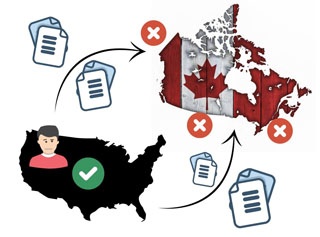 In our last blog article in this series, we looked at how the Globally Harmonized System of Classification and Labelling of Chemicals (GHS) is being embraced by Canada. We offered a broad outline of the situation, and the reasons why the system is now being implemented.
In our last blog article in this series, we looked at how the Globally Harmonized System of Classification and Labelling of Chemicals (GHS) is being embraced by Canada. We offered a broad outline of the situation, and the reasons why the system is now being implemented.
For this piece, we’ll take an informed look into more of the particulars, unearthing 5 key details in US/Canadian policy differences that could become potential pitfalls for companies looking to continue to smoothly export products to Canada.
Shifting SDS Legislation
As it stands, Canadian businesses, by and large, operate under the existing legislation which governs the use of chemical labelling – namely the Workplace Hazardous Materials Information System (WHMIS 1988). This is a comprehensive system for providing health and safety information in order to promote the safe use of hazardous chemicals in Canadian businesses.
As part of Canada’s transition towards GHS SDS compliance, this venerable system received an update with the arrival of WHMIS 2015. This is the same body of legislation as WHMIS 1988, but includes more comprehensive hazard criteria, classes and standardized language. Crucially, WHMIS 2015 uses the SDS format, phasing out the older MSDS format.
Once a particular organization has completely transitioned towards sole use of WHMIS 2015 in all its operations, it can be viewed as having transitioned fully to GHS. This completed transition makes the use of MSDSs fully obsolete.
The rules for this transition varies amongst three groupings: chemical producers, distributors and workplace employers.
Ultimately, manufacturers, having undergone this transition, will be expected to have their employees fully on board with WHMIS 2015, a requirement that will subsequently be enforced by inspection visits and audits, which will be looking for:
• Use of comprehension of the GHS symbols.
• Workforce knowledge of the legislation.
• The full and correct application of SDSs in the workplace.
Full use of WHMIS 2015 across every organization in these three groupings is scheduled for December 1, 2018. Our next article will take a look at the important staggered deadlines that will matter most in your transition.
5 Pitfalls to Look Out For
The differences between Canadian legislation, specifically between the WHMIS 2015 legislation, and the United States’ adopted GHS legislation (HCS 2012) are thrown into stark contrast once the details of both sets of legislation are examined. Understanding the differences between American and Canadian GHS implementations is essential for any business that does trade across North America.
While both broadly facilitate adoption, and enshrine similar requirements in both countries, there are some specific differences.
1. Canada’s Official Bilingualism
A factor that cannot be stressed enough is the federal requirement for both SDS documents and labels produced in Canada to be bilingual, displaying both English and French prominently. The need for such labelling is clear when taking into account Canada’s substantial French speaking population.
However, HCS 2012, the U.S. legislation governing this adoption, only makes provisions for the production of SDSs and labels in English. This means that an SDS sheet that is perfectly acceptable for use in the United States may be challenged in a Canadian workplace on language-grounds, with the argument that the label or SDS endangers workplace health by not making itself clearly understood in the environment in which it is being utilized.
Anyone authoring SDSs, either by hand or using an SDS authoring software, should now be looking to upgrade to secure the ability to author SDSs in multiple languages. For North American businesses, Spanish and French should be your first two targets. The best way to author in multiple languages is to have a system in place that generates a multilingual SDS directly from raw material and physical property data rather than pushing an English-language SDS through translation, as this may degrade the quality of data.
2. Container Label Differences
Another issue that has been identified is the discrepancy between Canadian and U.S. rules when it comes to labelling the exterior of a container (containing at least two hazardous products).
The rules are considerably less stringent in this area in the United States, where the legislation indicates that only the innermost container of any kit containing a hazardous product needs to be labelled with the usual warnings.
By contrast, in Canada the rules indicate that the outer container of any kit containing a hazardous product must be labelled.
This means that product kits that are created and labelled correctly in the United States could be viewed as dangerously under labelled upon arrival or export to Canada. The production and application of additional labels and SDSs must therefore be organized prior to exportation.
3. Biohazardous Infectious Materials
This is a point which could have substantial consequences for any business that has an involvement with infectious materials.
The overarching U.S. legislation covering SDS content does not regulate any biohazardous infectious materials – this is the domain of other legislation.
However, Canadian law indicates that any information of this kind must be clearly labelled, as well as being supplied as an appendix alongside the SDS documentation. This means that U.S. businesses exporting to Canada must ensure their labels and SDSs contain this biohazard information, even if it is not specifically required under U.S. GHS legislation.
4. Labelling of Carcinogenic Goods
Under the regulations to be adopted by both countries, any mixture that includes a Category 1 carcinogenic ingredient at a concentration of 0.1% or more requires both a specific SDS and a label in its packaging.
However, producers in the United States that create mixtures that contain Category 2 (less hazardous) carcinogens at a concentration of 0.1% or more are not required to have a specific label, whereas this is a requirement in Canada. While both countries deem an SDS as required for Category 1 and 2 at this concentration, a product, deemed as fully compliant in the United States, which is then exported to Canada, may be found lacking in affixed labels, creating a potential issue.
5. Updating Timeframes for SDSs and Labels
Another key difference in the set of regulations adopted by the two countries are the specific time limits within which written notice must accompany an SDS, once significant new data becomes available.
For Canadian producers, if a hazardous product is sold or imported within 90 days of this new data becoming available, a written notice providing the new data must be provided alongside the SDS document. This is lengthened to 180 days for labels.
However, American producers are not bound by the same written notice requirements. In the same situation, an American producer must update the concerned SDS with the relevant information within three months, or 6 months for labels.
This indicates the risk of a documentation shortfall when a product with new information is produced in the United States, shipped to Canada, and arrives without the necessary notice attached.
The Support Solution
Many companies cannot afford the delays and confusion that cross-border labelling and SDS issues throw up. These are sticking points that even adoption of the GHS across both countries cannot fully resolve.
In some cases, it may be worthwhile to arrange your SDS Authoring to the extent where two parallel SDSs, one oriented towards the US, and the other covering all Canadian requirements, may be needed. The right authoring system should be able to produce the right SDS at any given time, fully updated and ready for use with confidence. Is your business prepared with the right tools in place?
In order to produce and manage such an arrangement, having accurate and dependable SDS Authoring and Management tools is vital. As regulation changes, this is the system that should take these changes automatically into account.
In many cases, companies will have already spent a considerable amount of time and effort on bringing their SDS and labelling up to scratch, with adoption having been rolled out across the United States in 2015. If you’re using a system that only ensures U.S GHS compliance, you are likely missing out on some vital functions come June 1, 2017.
The adoption of the system across both the United States and Canada should help to smooth out a vast range of issues in the future, the reality of environmental and health & safety regulation is that changes happen on a constant, rolling basis, as new information on chemical products continually come to light. Revision is a constant concern.
ERA can help with the above instances – and offer a comprehensive SDS solution that can be tailored around your particular products and unique requirements.
This Blog was Co-Authored By:



September 19, 2016
Comments